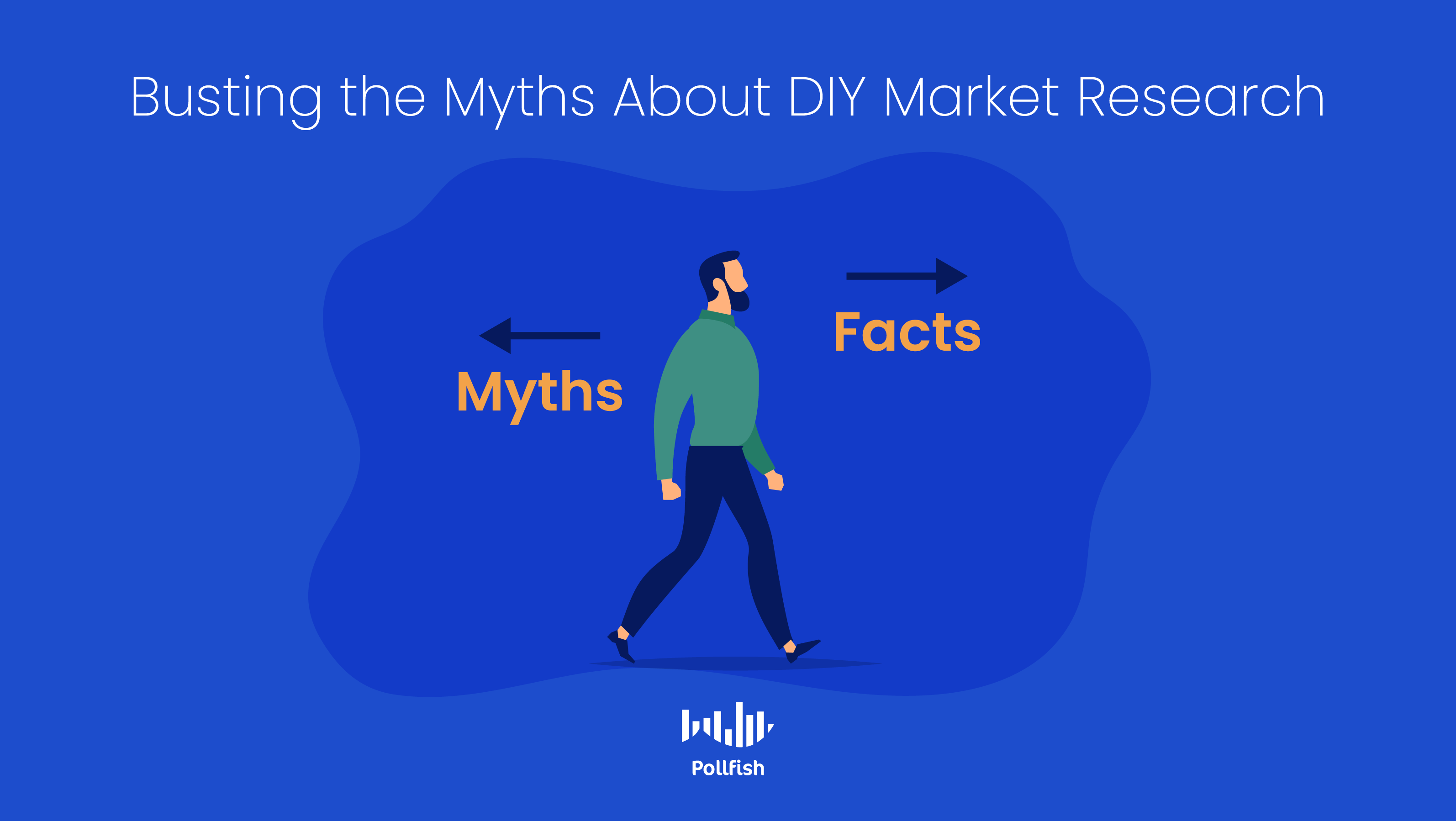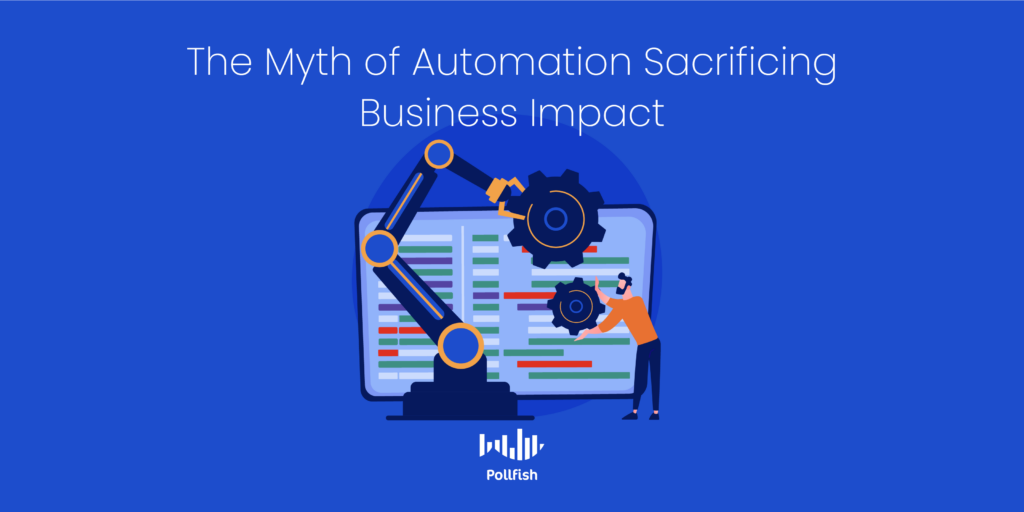Busting DIY Market Research Myths

DIY market research has made waves in the market research space, which had at one point been dominated by market research panels and external research firms. Come DIY market research, which brought the entire operation in-house.
This form of research upended the industry, allowing all organizations to conduct and own their market research. In turn, businesses were able to accelerate their processes, gaining quicker results and cutting costs.
Throughout the last few years especially, businesses have had an increasing desire to use DIY research practices. This need has increased throughout COVID-19 with slashed budgets, upskilled teams and the need for faster customer intelligence.
In fact, 54% of companies that have used DIY market research experienced financial growth. Additionally, almost half of market research professionals conduct more DIY research today than they did six years ago.
Despite the convenience and prevalence of the DIY method, negative myths still abound in the space. This article lays out four DIY market research myths and debunks them while proving their value.
Understanding DIY Market Research
DIY research or DIY market research is the practice of conducting market research that any person or organization carries out themselves. As such, the party conducting DIY research can be either a professional or a non-professional.
A kind of primary research, the DIY method uses online research methods, which usually takes the form of online research software or online survey tool. This method provides an avenue to conduct both quantitative and qualitative market research.
A strong DIY research platform provides the following capabilities:
- It can aggregate data from multiple sources.
- It will reach specific demographics, locations and other category-based criteria as indicated by the market researchers.
- It will provide an interface that allows market researchers to enter the stream and test their hypotheses for various types of research.
- It makes it easy to analyze consumer behavior to identify trends and themes.
- It allows researchers to deploy their surveys across a wide network of digital properties.
- It permits researchers to send surveys to specific, targeted individuals.
- It works quickly in extracting the correct data from the qualified population.
- It allows for exports, post-survey data filtering and various displays of the data.
Despite all of its provisions and conveniences, various actors maintain that DIY market research is not for all due to several limitations and factors of inferiority when compared with traditional market research. Despite the pervasiveness of DIY market research myths, they do not prove to be accurate.
Read along to understand why, as we bust four common myths surrounding the DIY approach to research.
DIY Market Research Myths in a Competitive Space
There are long-held myths surrounding the concept of DIY platforms and research. Businesses and market researchers must understand that many of the myths surrounding the DIY approach and its effectiveness are just that, myths.
For online survey platforms such as Pollfish to truly realize their potential in the space, researchers and market research agencies should pay no heed to the myths and misconceptions about DIY market research and instead funnel their energy into finding a strong online market research tool.
Such a tool would facilitate DIY market research with little labor involved from its users, marketers, researchers and business owners. For researchers to overlook the myths about DIY tools, we’ve laid out four to debunk.
DIY Market Research Myth 1: Complexity
DIY tools have many moving parts in the backend, such as segmentation, profiling, filtering and managing projects. With these hurdles, there is therefore also a learning curve to being active users of the tool. As such, the first myth is that DIY market research platforms are more complex than they’re worth using.

Although there are various components searchers would need to learn how to use, this couldn’t be further from the truth. This is because a strong DIY market research platform is made to be user-friendly, allowing its users to make your own survey in just a few steps. These aspects are the dominant traits of simplicity, diametrically opposing the concept behind this myth.
With various data visualizations such as charts, graphs, Excel files and more, researchers are in control of how they view and analyze their data. These are also easy to access, as they live on the DIY market research platform. This means businesses can cut through the middleman and access their data themselves, as opposed to using syndicated research, in which the market research firm you use owns all the data.
There is also no need to scout out research or survey panels, which are composed of pre-recruited respondents who agree to take part in a market research study. All researchers need to do is determine their audience, add in their questionnaire and launch the survey. That’s it. The DIY platform takes care of the rest.
This is a major reduction of labor, hassle and worry on the part of the market researchers using the DIY tool. As such, it is not merely a simple method, contrary to its myth, but it is one of the simplest if not the simplest way to conduct research.
Myth 2: DIY Platforms Favor Speed Over Quality
While it is true that DIY research platforms offer speed to insights and can empower researchers with an agile research strategy, they do not compromise speed over quality. Instead, these platforms offer both accelerated data collection and quality responses.
This will largely depend on the DIY market research platform you use. However, a robust platform often guarantees netting quality data only from researchers’ intended audience. It delivers this promise of quality data by preventing fraudulent responses. This involves using a series of in-platform mechanisms. These are powered by machine learning and require no effort on the part of both the researchers and the support staff of the DIY tool.
These mechanisms involve using a variety of quality checks that ensure there are no questionable respondents or faulty answers. Some of these quality checks include:
- No tolerance for gibberish answers
- Disqualification of VPN users
- Banning rule-breakers
- Barring respondents who provide one-word answers in open-ended questions that seek in-depth answers
- No tolerance for bots
- Avoidance of respondents with duplicated IDs via IP or MAC addresses, Google Advertising and mobile device identifiers
- Technical layers of quality checks
With the above quality checks and more working to eliminate any subpar data and suspicious respondents, market researchers are not sacrificing the quality of their research for the convenience of speed. Instead, a DIY market research platform couples speed with quality data.
Myth 3: DIY Platforms are Only Suitable for Simple Studies
The myth that DIY platforms lack the sophistication found in traditional research methods, such as using syndicated research or a market research agency has been long-established. After all, DIY market research platforms have given these organizations a run for their money and positioned themselves as legitimate threats.
Full-fledged market research agencies do offer value in the market research ecosystem, as they offer high-grade expertise in research design and storytelling. This gives their consumer base of market researchers a high level of quality behind their services.
However, these services do not render DIY market research platforms inferior. They are simply another route for conducting research, ones that are older and don’t offer all of the conveniences that market researchers have at their disposal by using a DIY market research tool.
One such convenience is building a multi-level survey campaign, the kind that offers various question paths via advanced skip logic, a mechanism that routes respondents to the appropriate follow-up questions based on their answer to a previous question.
This creates deep and multi-pronged question paths in the surveys that researchers create, allowing them to reap granular insights and deeply explore a topic, despite the different customer personas present and their varying answers.
They can do all of this in just one survey. Thus, this capability disproves the fact that DIY market research platforms can only be used for simple studies.
Moreover, DIY survey platforms allow market researchers to segment qualified respondents in an ultra-granular way. This means they would not simply tick off demographics, psychographics and location when profiling their qualified users in their screening section.
Instead, they can qualify and disqualify respondents from taking a survey based on their answers to specific questions in the screening section, which makes the segmentation process extremely granular. Researchers will never be left wondering if the right people are taking part in their surveys.
In addition, they can add multiple audiences to their surveys, which grants researchers the ability to include multiple groups of respondents with distinct characteristics to partake and be examined in just one survey. A tool that can do this isn’t lacking when it comes to conducting complex studies.
As such, DIY survey platforms are well-equipped to manage complex campaigns that require deep segmentation, multiple audiences and varied question paths.
Myth 4: Automation Sacrifices Business Impact
This myth is centered on the idea that using a DIY market research tool removes the human-led element of storytelling available in research agencies, thereby making this kind of tool less insightful and far less impactful on the overall research campaign. This is a myth as DIY research platforms are continuously augmenting their capabilities.

At Pollfish, for example, there are ongoing updates to the product which makes it more innovative, practical and adept at keeping up with changes in the industry.
The constant updates present in DIY market research include real-time analytics solutions and dashboards, which show the progress of a survey while it is still running. They also make it possible to access the data in various formats, visualizations and organizational styles, such as filtering post-survey data in the dashboard to focus on specific demographics and answers.
These automation-based features enable the DIY platforms to ensure data democratization, which entails all members of a business having easy access to insights, whether they are market analysts or in a far different department such as e-commerce, marketing, C-suite, etc.
These capabilities provide sufficient impact for businesses on a wide spectrum of efforts, such as marketing, sales, and advertising as they enable them to make data-driven business decisions, the kinds that are mission-critical.
Making All the Right Market Research Moves
Using DIY market research allows you to efficiently perform all the research you require for multiple projects. While it is clear as to why DIY market research myths are invalid and are just myths, it is important to understand that not all DIY market research platforms are built with the same interfaces and capabilities.
Market researchers should choose an online DIY platform with features that easily disprove these four myths and others. This way, they can safely carry out their market research campaigns, knowing that they’ll reap accurate and high-quality results.
To do so, they ought to look into a strong online survey platform, the kind that operates via random device engagement (RDE) sampling, which reaches respondents in their natural digital environments, which, in turn, cuts out survey bias.
Market researchers should also opt for an online survey platform that implements artificial intelligence and machine learning to disqualify survey fraud and poor-quality data, provide a mobile-first approach design and offer the Distribution Link feature, which allows researchers to send surveys to specific targets, as opposed to a random pool.
When you use an online survey tool of this caliber, you can rest assured that no myths, no faults or other market research issues stand a chance in marring your market research.
Do you want to distribute your survey? Pollfish offers you access to millions of targeted consumers to get survey responses from $0.95 per complete. Launch your survey today.
